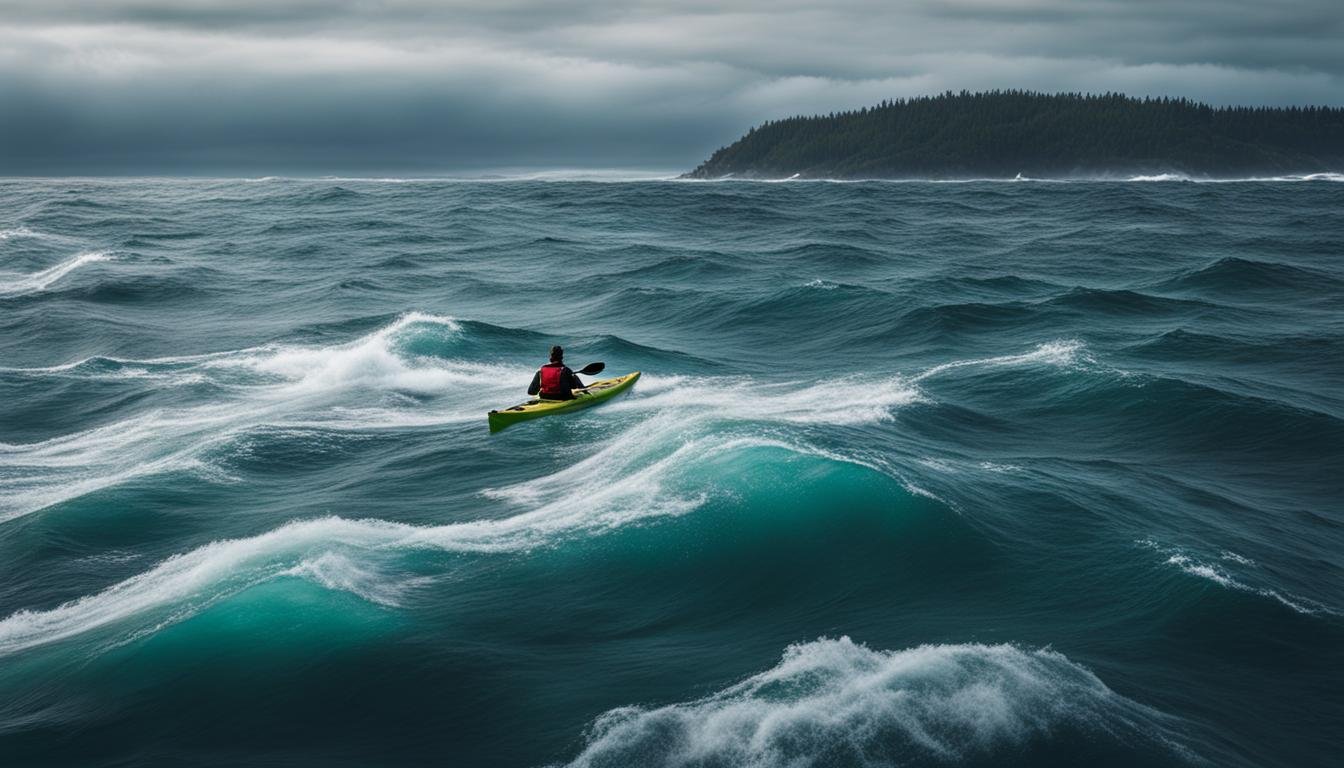How Much Wind is Too Much for Kayaking
When it comes to kayaking, wind conditions play a crucial role in your safety and overall experience on the water. Knowing how much wind is too much and understanding the impact it can have on your kayaking adventure is essential. In this article, we will explore the safe limits for kayaking in high winds and provide valuable insights into kayaking safety and wind conditions. So, let’s dive in and learn how to navigate the winds like a pro!
Key Takeaways:
- Understanding wind speed and direction is crucial for assessing kayaking conditions.
- Generally, winds below 10 knots are safe for kayaking, but offshore breezes can pose challenges.
- Water choppiness and waves should also be considered when determining wind limits.
- For recreational kayaking, wind speeds above 15 knots are considered dangerous.
- Sea kayaking and whitewater kayaking have different wind limits due to varying conditions.
Wind Limits for Recreational Kayaking
When it comes to recreational kayaking on lakes, ponds, and slow-moving rivers, it’s important to understand the wind limits to ensure your safety on the water. Generally, wind speeds below 10 knots (about 11.5 mph) are considered safe for kayaking. At this speed, you can still effectively maneuver your kayak without much difficulty. However, as the wind speed increases, it can start to impact your paddling ability and lead to fatigue. It’s important to be aware of the wind conditions before heading out and to have an exit strategy in case the wind becomes too strong.
If the wind speed exceeds 10 knots, it’s recommended that less experienced kayakers stay close to shore. Stronger winds can make it more challenging to paddle and control your kayak, especially if you’re further away from the shoreline. It’s always better to err on the side of caution and avoid venturing too far into open water when the wind speed picks up.
To give you a better understanding of safe wind limits for recreational kayaking, here’s a table summarizing the wind speeds and their corresponding impact on paddling ability:
| Wind Speed | Impact on Paddling Ability |
|---|---|
| Below 10 knots (about 11.5 mph) | Safe, easy to maneuver |
| Around 10-15 knots (about 11.5-17 mph) | Increasing difficulty, potential fatigue |
| Above 15 knots (about 17 mph) | Dangerous, challenging to paddle |
Remember to always check the weather forecast and assess the wind conditions before setting out on your kayaking adventure. By being aware of the wind limits and taking necessary precautions, you can ensure a safe and enjoyable experience on the water.
Wind Limits for Sea Kayaking
Sea kayaking on open ocean waters can be a thrilling adventure, but it also comes with its challenges. One of the most important factors to consider when planning a sea kayaking trip is the wind speed. Understanding the wind limits for sea kayaking is crucial for your safety and enjoyment on the water.
Safe wind limits for sea kayaking generally range from 4 to 7 knots (about 4.6 to 8 mph). At these wind speeds, you’ll experience manageable wave intensity and spray. However, as the wind speed increases, so does the difficulty level of navigating and controlling your kayak. When wind speeds exceed 8 knots (about 9 mph), it becomes increasingly challenging to maintain your course and handle the kayak effectively.
Dangerous wind limits for sea kayaking are typically around 10 knots (about 11.5 mph) or higher. Strong winds can create larger waves and make it harder to stay on course, increasing the risk of capsizing or getting blown off course. It’s important to check the weather forecast before heading out and have the proper safety equipment, such as a personal flotation device and a paddle float, when sea kayaking. Paddling with a partner is also recommended to ensure mutual assistance in challenging conditions.
Factors to Consider
- Wind speed: Stay within the safe wind limits for sea kayaking and be mindful of rapid changes in wind speed.
- Wind direction: Consider how the wind direction may affect your paddling experience and plan your route accordingly.
- Wave intensity: Strong winds can increase wave height and choppiness, making it more challenging to navigate.
- Weather forecast: Always check the forecast before setting out on a sea kayaking trip and be prepared for potential changes in weather conditions.
Safe Practices for Sea Kayaking
- Paddle with a partner: Having a buddy with you on the water ensures mutual support and assistance in case of challenging conditions.
- Be familiar with the local area: Know the coastline, potential hazards, and safe landing spots along your planned route.
- Communicate with others: Let someone on land know your intended route and expected return time.
- Wear appropriate gear: Dress in layers and wear a wetsuit or drysuit if necessary, especially in colder water temperatures.
- Practice self-rescue techniques: Be proficient in re-entering your kayak after capsizing and know how to perform a paddle float rescue.
| Wind Speed | Wave Intensity | Difficulty Level |
|---|---|---|
| 4-7 knots (4.6-8 mph) | Manageable | Intermediate |
| 8-10 knots (9.2-11.5 mph) | Moderate | Advanced |
| Above 10 knots (11.5 mph) | High | Dangerous |
Wind Limits for Whitewater Kayaking
Whitewater kayaking is an exhilarating and challenging sport that requires skill and technique. When it comes to wind limits for whitewater kayaking, there are certain factors to consider to ensure a safe and enjoyable experience on the rapids.
Wind Speed and Control
Safe wind limits for whitewater kayaking typically range up to 15 knots (about 17 mph). Beyond this speed, the strong winds can impact the maneuverability and control of the kayak, making it harder to navigate through the rapids. It’s important to be aware of the wind speed and its potential to affect your ability to steer and paddle effectively.
Whitewater Conditions
It’s crucial to understand that wind speed is not the only consideration when it comes to whitewater kayaking. The conditions of the rapids, such as water flow, turbulence, and obstacles, play a significant role in determining the safety and feasibility of kayaking. It’s essential to assess the overall conditions before embarking on a whitewater kayaking adventure.
Stormy and Rainy Days
Engaging in whitewater kayaking during stormy or rainy weather is highly discouraged. Strong winds accompanied by heavy rainfall can create unpredictable currents and hazardous conditions on the rapids. It’s essential to prioritize your safety and avoid kayaking during unfavorable weather conditions.
| Wind Speed | Condition |
|---|---|
| Up to 15 knots (17 mph) | Safe wind limits for whitewater kayaking |
| Around 20 to 25 knots (23 to 29 mph) | Dangerous wind limits for whitewater kayaking |
Remember, whitewater kayaking requires experience, proper training, and respect for the natural elements. Always prioritize your safety and adhere to recommended wind limits to enjoy a thrilling and safe whitewater kayaking adventure.
Wind Limits for Kayak Fishing
When it comes to kayak fishing, understanding the wind limits is crucial for a safe and successful outing. Knowing the safe wind limits for kayak fishing can help you make informed decisions about when to head out on the water and when to stay ashore. It’s important to remember that wind can affect stability, control, and your ability to stay in position while fishing.
Generally, safe wind limits for kayak fishing are around 10 to 15 knots (about 11.5 to 17 mph). Wind speeds within this range allow for comfortable fishing and navigation. However, it’s important to note that wind conditions can vary depending on factors such as your location, the size of the body of water, and the specific fishing techniques you plan to use. It’s always recommended to check the weather forecast before heading out and to use your judgment to assess the wind conditions based on your experience and skill level.
When wind speeds exceed 15 knots (about 17 mph), kayak fishing can become more challenging. Strong winds can make it difficult to maintain control of your kayak and can impact your ability to cast, reel in fish, and maintain your position. In these conditions, it’s generally advisable to fish close to shore where you can seek shelter from the wind, or, if the conditions are too unfavorable, consider postponing your fishing trip to a calmer day.
Remember, safety should always be your top priority when kayak fishing. Be sure to wear a personal flotation device, familiarize yourself with the local waterways, and let someone know your fishing plans. By respecting the wind limits and taking necessary precautions, you can enjoy a memorable and safe kayak fishing experience.
| Wind Speed | Suitable for Kayak Fishing |
|---|---|
| Below 10 knots (about 11.5 mph) | Safe and comfortable conditions for kayak fishing |
| 10-15 knots (about 11.5 to 17 mph) | Ideal wind conditions for kayak fishing |
| Above 15 knots (about 17 mph) | Challenging conditions for kayak fishing; consider fishing close to shore for better protection from wind |
Identifying Wind Speed and Direction
When planning a kayaking trip, it is crucial to identify the wind speed and direction to assess the suitability of the conditions. Knowing these factors will help you make informed decisions and ensure your safety on the water. There are various methods and tools available to identify wind speed and direction, providing you with the necessary information for a successful kayaking experience.
Identifying Wind Speed
One way to determine wind speed is by using an anemometer, a handheld device specifically designed for measuring wind speed. Anemometers are easy to use and provide accurate and reliable readings. If you don’t have access to an anemometer, you can also check wind forecasts from reliable sources such as WindAlert or NOAA. These forecasts give you an estimate of the wind speed, allowing you to plan your kayaking trip accordingly.
Identifying Wind Direction
Understanding wind direction is vital for effective navigation and maximizing your safety on the water. Paddling into headwinds can be challenging, while tailwinds can provide a helpful boost. To determine wind direction, you can observe the movement of nearby vegetation or flags. Additionally, weather vanes or windsocks can indicate the direction of the wind. By being aware of the wind direction, you can plan your route and adjust your paddling techniques accordingly.
By paying attention to wind speed and direction, you can adapt your kayaking plans and make the necessary adjustments to ensure a safe and enjoyable experience on the water. Remember to use wind measuring tools or reliable forecasts to accurately assess the wind conditions before setting off on your kayaking adventure.
| Wind Speed | Wind Direction |
|---|---|
| Below 10 knots (about 11.5 mph) | No specific impact, choose preferred direction |
| 10-15 knots (about 11.5 to 17 mph) | Pay attention to headwinds and tailwinds |
| Above 15 knots (about 17 mph) | Be cautious and adapt paddling techniques |
Conclusion
Wind plays a significant role in the safety and enjoyment of kayaking. Understanding the wind limits for different types of kayaking and waterways is essential for planning a safe and enjoyable trip. Whether it’s recreational kayaking, sea kayaking, whitewater kayaking, or kayak fishing, being aware of wind speeds, water conditions, and having the necessary safety equipment is key.
By following these guidelines and monitoring wind conditions, you can embark on your paddling adventures with confidence and make the most of your time on the water. Remember to check the weather forecast before heading out and familiarize yourself with the wind speed and direction. Consider the specific recommendations for different types of kayaking and always prioritize safety.
Whether you’re a beginner or an experienced kayaker, respect the wind and its potential impact on your paddling experience. Stay informed, stay prepared, and enjoy the thrill of kayaking while staying safe on the water.
FAQ
How much wind is too much for kayaking?
Generally, wind speeds below 10 knots (about 11.5 mph) are safe for kayaking. However, wind can be deceiving, and it’s important to consider factors like the waves and your own experience level. When wind speeds approach 12 knots (14 mph), it’s recommended for less experienced kayakers to stay close to shore.
What are the wind limits for recreational kayaking?
Wind speeds below 10 knots (about 11.5 mph) are generally safe for recreational kayaking. Above 10 knots, paddling ability can be affected, and above 15 knots (about 17 mph) is considered dangerous for recreational kayaking.
What are the wind limits for sea kayaking?
Safe wind limits for sea kayaking are generally around 4 to 7 knots (about 4.6 to 8 mph). Above 8 knots, it can become difficult to navigate and control the kayak. When wind speeds exceed 10 knots (about 11.5 mph), sea kayaking becomes dangerous due to larger waves and difficulty staying on course.
What are the wind limits for whitewater kayaking?
Wind speed is not the primary concern for whitewater kayaking, but wind can still impact maneuverability. Safe wind limits for whitewater kayaking are typically up to 15 knots (about 17 mph), and dangerous wind limits are around 20 to 25 knots (about 23 to 29 mph).
What are the wind limits for kayak fishing?
Safe wind limits for kayak fishing are generally around 10 to 15 knots (about 11.5 to 17 mph). Wind speeds above 15 knots can make it challenging to fish and maintain control of the kayak.
How can I identify wind speed and direction?
Wind speed can be measured using tools like an anemometer or by checking wind forecasts from reliable sources. Observing wind conditions and using the Beaufort Scale can also provide a rough estimate of wind speed. Wind direction is important for determining the best route, and being aware of headwinds or tailwinds can help in navigating safely.







